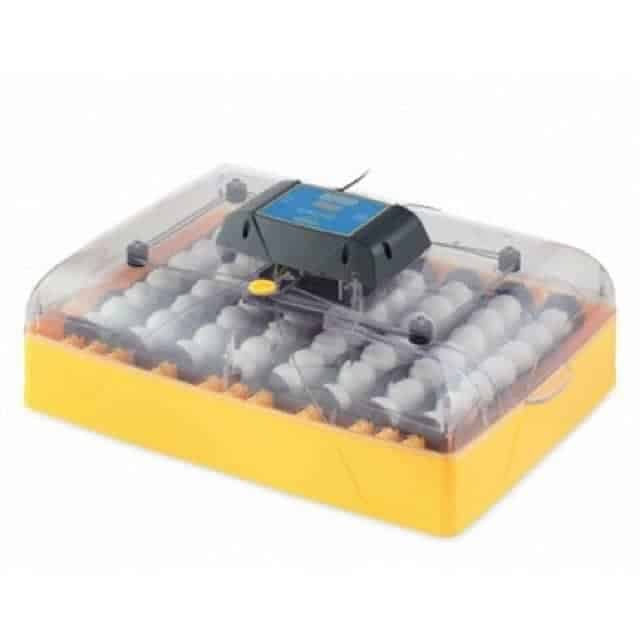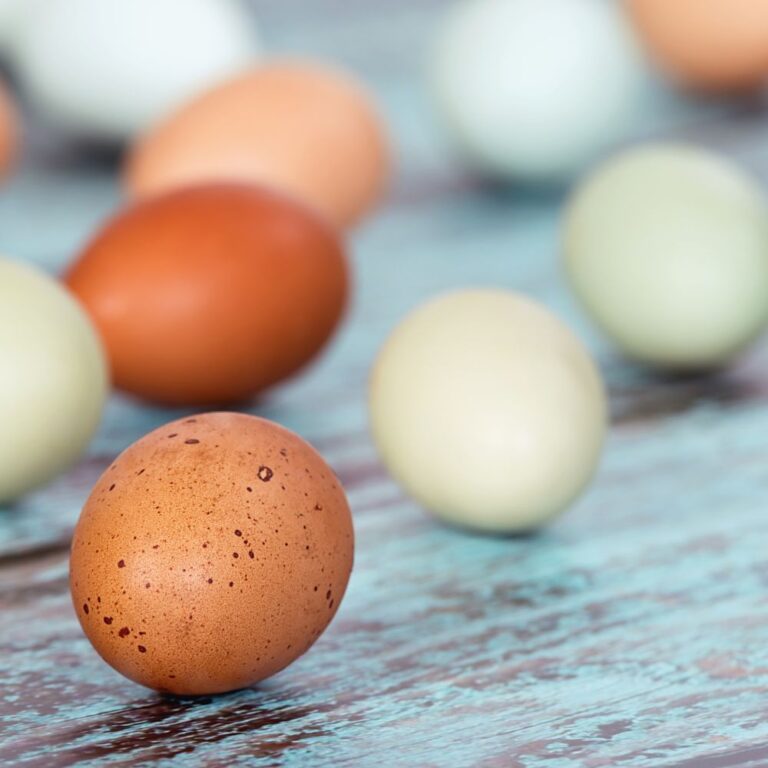Did you get chicks this spring? Me too. Soon they’ll start laying, but if you let your hens free range, you might not find those eggs easily. Here are some of the best ways to tell if your hens are laying!
Even if you keep your hens in an enclosed area, knowing when they’re ready to lay is one of the most exciting moments of chicken ownership.
I’ve ranked these ways in the order I use on our homestead because they’ve worked well for me and my flock.

1. Look at your hens’ comb and wattles (The best way I use)
I like using the comb and wattles (and the area around the eyes to a certain extent) to tell if my hens are laying or might lay soon.
It’s not the most scientific way, but it’s the least invasive, and in my experience, reasonably accurate.
Take a walk out to your coop and look at your pullets – what do their combs and wattles look like? Are they vibrant red or dull?
Are the wattles small, or are they starting to droop and sag?

These two pullets are from the same hatch, but the pullet on the right looks like she might lay soon. Her waddles are longer and redder than the pullet on the left.
Vibrant red wattles are my best bet for telling whether my chickens are laying (aside from the hens laying an egg in front of me).
When Qwerty was about 6 months, the length and color of her wattles quickly started to change.
Her comb also became more prominent, and the color around her eyes changed, and sure enough, she soon started to lay eggs.
Qwerty came to the homestead with 2 other pullets, also Blue Copper Marans, who were born 4 weeks after her. One has wattles that have started to change, while the other one from the same hatch hasn’t.
You can easily see the difference between the two. While I’m not sure the pullet is laying yet, I’ve isolated her from my other laying hens to find out! I’ll be keeping an eye on that nest box for sure! More on isolation below.
2. Behavior (My second best way to tell)
If you have a rooster, this is one of the best ways to tell if your hens are laying.
Watch your hen’s behavior – is she happy-go-lucky as a pullet, eating and minding her own business, or has she become glued to the hip with a rooster?
Roosters don’t really worry too much about pullets that aren’t laying. Once the hens are ready to produce eggs, though, it’s a different story.
The rooster starts to feel more possessive and does his “mating dance” around her to show that’s his girl. It’s hilarious and a good indicator that your pullets are becoming hens.
I definitively knew Qwerty was entering the egg layer group when my king rooster stole her from another rooster, Lavender (whom she was best buds with). I was pretty sure she had started laying or would lay very soon.
3. Skin Bleaching
This one gets a little tricky and takes some experience to determine. Here’s a short description of this process:
As hens start laying, they divert the yellow color in their skin pigment from their vent, eye rings, legs, and beak to their yolks.
The vent is the first to start losing its yellow color. The yellow will fade from the vent within the first week of laying and become white, pink, or bluish-white.
Within 2 weeks, the eye rings will start to bleach, and finally, her beak will begin to lose its pigment, too, starting at the base and heading out toward the tip.
A hen that shows black in its beak is likely laying, although this is breed dependent since darker-colored breeds sometimes have dark beaks.
It takes 4-8 weeks for the beak to begin to bleach. Hens that have beaks that aren’t bleached haven’t started laying or haven’t laid an egg for 4-6 weeks.
4. Feathers
Think about how neat and shiny a pullet looks as opposed to hens who are laying regularly.
Hens who have been laying will have feathers that are possibly broken or rumpled, while hens with sleek and clean-looking feathers might not be laying.
While messy feathers are a good sign of egg laying, I don’t use it as a sign alone, instead, I use it as a secondary indicator.
I think the methods outlined above are the best ways to tell if your hens are laying.
Regarding feathers, keep in mind that molting is almost always a sure sign your hens aren’t laying since the bird needs to put her energy into making new feathers instead of eggs.
When hens molt, it’s always in a certain order. The feathers are first lost from the head, then on the neck, breast, body, wings, and tail in that order. They also lose their primary flight feathers before secondary flight feathers on the wings.
5. Isolate them or keep them in an enclosed area if they’re free-range birds
When in doubt…if your hens seem like they should be laying but you have no eggs, pen them in an isolated area that’s safe, has water and shelter, and see if they will lay.
In my experience, if your hens aren’t used to being penned this process can cause a good deal of stress for them. It can take up to 2 weeks for them to start laying again, so give them time if you do decide to pen them.
We had laying hens, but no eggs. We didn’t realize the cause of the problem was an overly aggressive rooster who was creating large wounds in the hens (which were hidden by their wings and feathers) until we isolated the hens from the rest of the flock.
After a couple of weeks and a bump in their protein, the girls started laying again.
Bonus Tip
There might also be nutritional reasons your hens might not be the best layers. This is a very important topic. If your hens aren’t layinglaying it’s very likely that they do not have enough proteinor nutrients of some kind. Be sure you are feeding them a high protein diet with good ingredients. Also, make sure they are getting enough food.
Tips For Egg Production
- Be sure your flock is getting plenty of protein in their layer feed and treats
- You may want to consider giving oyster shells for extra calcium
- Boost your bird’s immune system and egg production with vitamins and nutrients
- Ensure they have fresh clean water every day (and give them warm water in cold weather)
- Make sure they have privacy where you want them to lay eggs (they like and need privacy)
Not sure which chicken breeds are the best at laying? Here are 5 breeds to check out and here’s what to feed your hens for great tasting eggs!
Summary
If you are trying to figure out if and when your backyard chickens are laying, try out these methods. You have nothing to lose and knowledge to gain. Best of luck to you! And may your days be filled with chicken eggs.
Additional Backyard Flock Articles
- Buff Orpingtons: Buyer’s Guide
- Chicken Feather Loss – Grow Feathers Back Fast
- Fast Facts About Rhode Island Reds and the 10 Best Hatcheries to Buy Them From
- Raise Blue Laced Red Wyandottes – For A Colorful Flock of Chickens!
- Black Copper Marans – Do They Really Lay Chocolate Eggs?
- When Will Chicks Start Laying Eggs?
Maat van Uitert is a backyard chicken and sustainable living expert. She is also the author of Chickens: Naturally Raising A Sustainable Flock, which was a best seller in it’s Amazon category. Maat has been featured on NBC, CBS, AOL Finance, Community Chickens, the Huffington Post, Chickens magazine, Backyard Poultry, and Countryside Magazine. She lives on her farm in Southeast Missouri with her husband, two children, and about a million chickens and ducks. You can follow Maat on Facebook here and Instagram here.










I just got a rooster! I’m hoping my hens will finally lay eggs!
Roosters are awesome! Here’s to getting some fertilized eggs! What breed did you get?